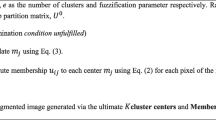Abstract
Fuzzy c-means (FCM) algorithm is one of the most popular methods for image segmentation. However, the standard FCM algorithm must be estimated by expertise users to determine the cluster number. So, we propose an automatic fuzzy clustering algorithm (AFCM) for automatically grouping the pixels of an image into different homogeneous regions when the number of clusters is not known beforehand. In order to get better segmentation quality, this paper presents an algorithm based on AFCM algorithm, called automatic modified fuzzy c-means cluster segmentation algorithm (AMFCM). AMFCM algorithm incorporates spatial information into the membership function for clustering. The spatial function is the weighted summation of the membership function in the neighborhood of each pixel under consideration. Experimental results show that AMFCM algorithm not only can spontaneously estimate the appropriate number of clusters but also can get better segmentation quality.



Similar content being viewed by others
References
Ball G, Hall D (1967) A clustering technique for summarizing multivariate data. Behav Sci 12:153–155
Bezdek JC (1974) Cluster validity with fuzzy sets. J Cybern 3:58–73
Bezdek JC (1975) Mathematical models for systematic and taxonomy. In: Proceedings of eight international conference on numerical taxonomy, San Francisco, pp 143–166
Bezdek JC (1981) Pattern recognition with fuzzy objective function algorithms. Plenum Press, New York
Dunn JC (1974) A fuzzy relative of the ISODATA process and its use in detecting compact, well-separated clusters. J Cybern 3:32–57
Hall LO, Kanade PM (2005) Swarm based fuzzy clustering with partition validity. Proc. 14th IEEE Int. Conf. on Fuzzy Systems (FUZZ-IEEE’05). IEEE Press, Piscataway, NJ. 991–995
Hall LO, Kanade PM (2007) Fuzzy ants and clustering. IEEE Trans Syst Man Cybern A Syst Hum 37(5):758–769
Huang GR, Wang XF, Cao XB (2006) Ant colony optimization algorithm based on directional pheromone diffusion. Chin J Electron 15(3):447–450
Kim DW, Lee KH, Lee D (2004) On cluster validity index for estimation of optimal number of fuzzy clusters. Pattern Recognit 37:2009–2024
Pal NR, Bezdek JC (1995) On cluster validity for the fuzzy c-means model. IEEE Trans Fuzzy Syst 3(3):370–379
Pham DL, Prince JL (1999) An adaptive fuzzy c-means algorithm for image segmentation in the presence of intensity inhomogeneities. Pattern Recognit Lett 20:57–68
Samarasekera S (1996) Fuzzy connectedness and object definition: theory, algorithm and applications in image segmentation. Graph Models Image Process 58(3):246–261
Shelokar PS, Jayaraman VK, Kulkami BD.(2004) An ant colony approach for clustering. Anal Chim Acta 509(2):187–195
Tou JT, Gonzalez RC (1974) Pattern recognition principles. Addison-Wesley, London
Wallace CS, Boulton DM (1968) An information measure for classification. Comput J 11(2):185–194
Xie XL, Beni GA (1991) Validity measure for fuzzy clustering. IEEE Trans Pattern Anal Mach Intell 3:841–846
Yamany SM, Farag AA, Hsu S (1999) A fuzzy hyperspectral classifier for automatic target recognition (ATR) systems. Pattern Recognit Lett 20:1431–1438
Acknowledgments
The authors would like to thank the anonymous referees for their helpful comments and suggestions to improve the presentation of the paper. This research is supported by the National Natural Science Foundation of China (No. 60874031), the Fund for International Cooperation and Exchange of the National Natural Science Foundation of China (No. 60740430664) and the Special Research Fund for the Doctoral Program of Higher Education of China (20070487052).
Author information
Authors and Affiliations
Corresponding author
Rights and permissions
About this article
Cite this article
Li, Yl., Shen, Y. An automatic fuzzy c-means algorithm for image segmentation. Soft Comput 14, 123–128 (2010). https://doi.org/10.1007/s00500-009-0442-0
Published:
Issue Date:
DOI: https://doi.org/10.1007/s00500-009-0442-0




